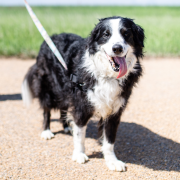Thank you to Midtown Veterinary Medical Center for guest writing this blog, as part of our monthly Business Partner Program. Midtown Veterinary Medical Center provides a wide range of veterinary services for cats and dogs. Learn more here or call 970-305-5522.
With summer finally here, many of us are looking forward to hiking or camping with our dogs! Just as we take precautions to keep ourselves safe, it’s essential to be prepared for any mishaps that may occur with our pets while outdoors. Here are some tips for keeping pets safe while enjoying beautiful outdoor Colorado.
It’s a good idea to travel with a pet-specific first aid kit. It should include bandaging materials such as gauze, cling wrap, adhesive tape, scissors and a plastic bag or MediPaw sleeve to keep bandaged feet dry and clean; antiseptic wipes; a thermometer; tweezers; saline flush (same as you use for human contact lenses); a muzzle (injured, fearful or painful dogs can sometimes bite even people they know); clean towels and a blanket. An extra leash and collar are a good idea as well. And of course, always carry a collapsible bowl, food and extra water for your dog.
Safety starts with getting to your destination. Make sure that your car is cooled off before loading your dog and never leave a dog in a car during warm weather (even 60’F is too hot for some breeds!). Make sure your dog is safely restrained either in a crate or with a dog-specific harness/seatbelt apparatus.
Always respect trail or campground pet access rules and adhere to leash laws. This alone will avoid most injuries or accidents.
The first and most important way to keep your dog safe is to ensure they are socialized to behave appropriately during interactions with other animals and people you will encounter on the trail, and that they are appropriately well trained to respond to your commands. The most important commands to master are the “come,” “leave it,” and “drop it” commands. These are potentially lifesaving skills for dogs, keeping them from getting lost if they should get away from you, and effectively disengaging their attention from dangerous objects or wildlife, or from picking up and eating something dangerous or disgusting. There are many excellent dog training schools in the Ft. Collins area; ask your veterinarian for a recommendation.
Despite all precautions, pets will be pets and sometimes still get into trouble on the trail. Here are some of the common outdoor-related injuries or emergencies that can happen on the trail and how you can address them in the moment:
- Paw pad injuries
- Eye injuries
- Lacerations
- Ingestion of toxic substances, plants or foreign matter
- Heatstroke
- Rattlesnake bites and other wildlife encounters
In all of the following scenarios, remember that first aid is an important first step, but it is not a substitute for veterinary care. After giving first aid as described below, head immediately to your vet’s office or the nearest veterinary emergency facility for further care. Always keep your vet’s phone number and the phone numbers and locations of area emergency hospitals handy; try to call ahead to give them information about your pet’s condition and your ETA.
Paw Pad Injuries
Foot and paw pad injuries occur when the surface substrate is too hot or too coarse for the pads. If the ground surface is too hot for you to comfortably rest your hand on it, it’s too hot for your dog’s pads. Running on gravely substrate can potentially “skin off” the thick, specialized pad skin, creating an open wound on the bottom of the foot, a very painful condition. If this happens you may end up carrying your dog all the way back to your car! Apply a light padded bandage or a MediPaw cover to keep the bandage dry.
Eye Injuries
Brush and debris near the trail and at eye level for dogs is a potential hazard and dogs’ eyes can get scratched, punctured, or even embedded with plant debris. If your dog gets a sudden squinty eye or begins rubbing at the eye, and if you can see debris in the eye, try flushing it out with saline. Don’t allow your dog to rub at the eye with their paw as this can exacerbate damage to the eye.
Cuts/Bleeding
If your dog suffers a cut and is bleeding, apply pressure to the area with a clean towel. If bleeding heavily, apply more towels on top of the first rather than removing it (to avoid disrupting a clot that might be forming).
Ingestion of Foreign Material
If your dog manages to pick up something in its mouth the “drop it” command is your friend. If that fails or if your dog is choking, keep them as calm as possible and, if safe, attempt to open their mouth and remove the object. Be careful not to push the object further down the throat! If all else fails, the Heimlich maneuver can be effective, especially on larger dogs. If your dog actually swallows something potentially sharp or toxic, seek immediate veterinary care.
Heatstroke
This is a life-threatening condition. An overheated dog may display rapid, heavy breathing or panting, excessive drooling, dark colored or sticky/dry gums, vomiting or diarrhea, weakness or even collapse. Move your dog to a cooler or shady place and apply cool water or wet towels to the neck, paw pads, armpits and groin area. If a fan is available, use it to blow cool air over the dog. DO NOT place them in cold water or apply ice packs. Monitor rectal temperature; if it is 104’F or over, and especially if it is rising higher, you must seek veterinary care immediately.
Snakebite
In Colorado we share the trails with rattlesnakes. Dogs are often the unfortunate victims of a strike; the venom is extremely toxic and caustic and can cause severe tissue damage or death. Staying on trails and strict adherence to leash laws is the best way to avoid this emergency. Signs of a snake bite are yelping or sudden lameness if a leg is struck, extreme swelling or bleeding at the site of strike, difficulty breathing, weakness or collapse. Remove the dog from the area of the snake and be careful that you don’t get bit yourself! If you can do so safely, snap a photo of the snake to confirm species. Minimize the dog’s movement to limit the spread of the venom (carry them to your car if possible) and go immediately to the nearest veterinary emergency hospital. Many cases, but not all, require treatment with rattlesnake antivenin. Most ER’s stock the antivenin but it sometimes is in short supply. Call ahead to confirm the hospital has antivenin on hand and let them know your ETA.
There are many reputable sources of more in-depth pet emergency information available. Some of these include The American Veterinary Medical Association and the American Red Cross (which also offers a free pet first aid app).
Wishing you a wonderful and safe summer with your furry friends!





